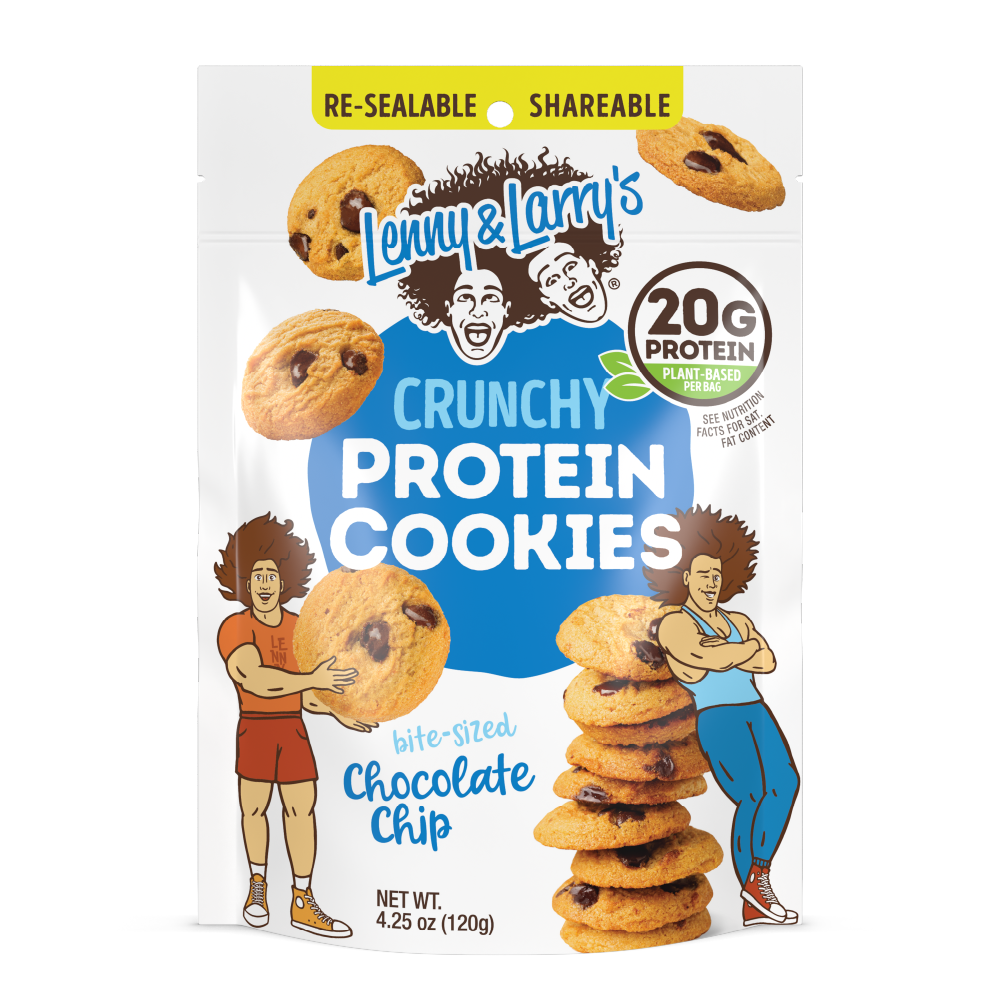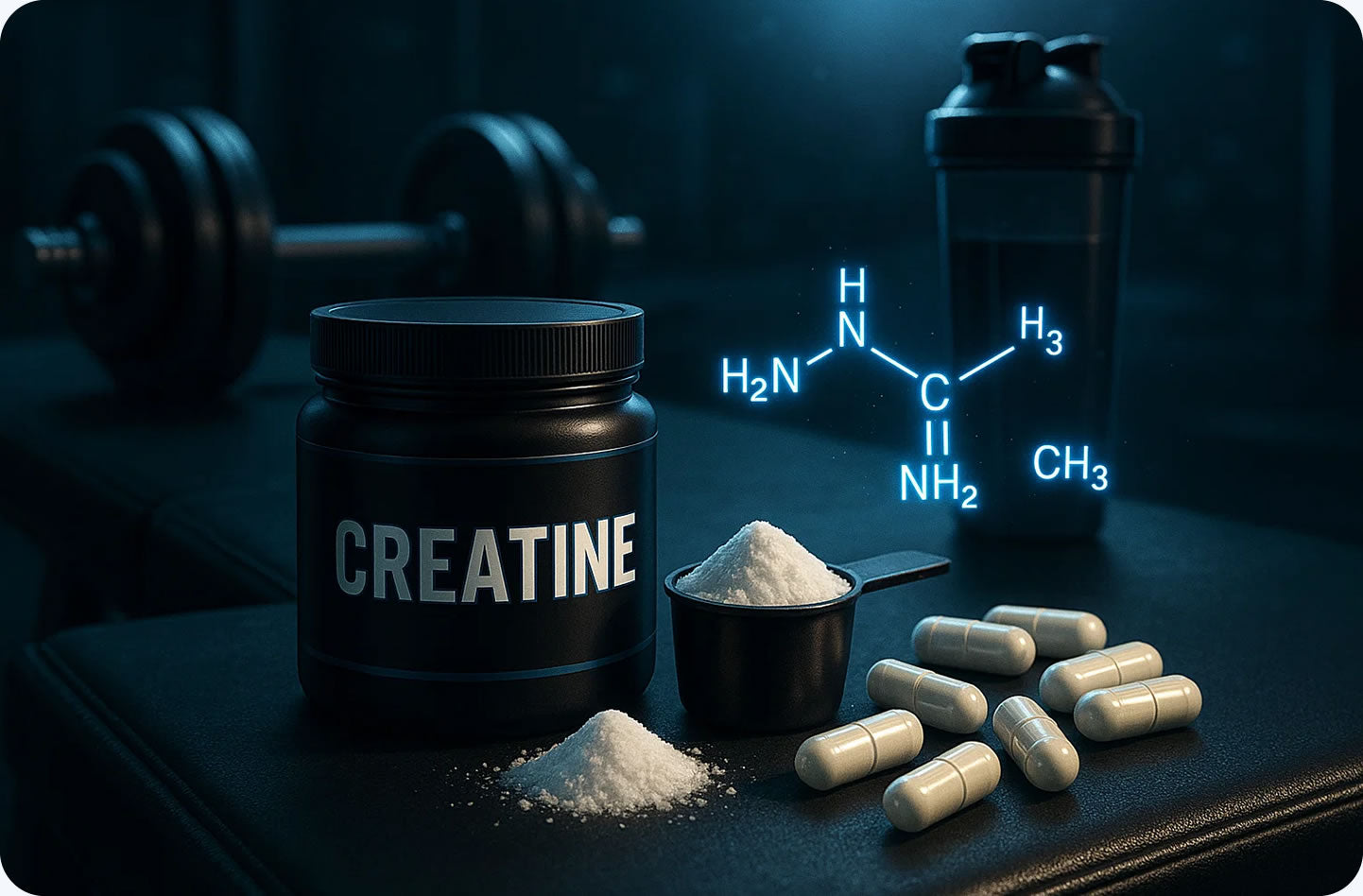If you're serious about building strength, boosting athletic performance, or gaining muscle mass, creatine has already made it onto your radar. It's one of the most studied and effective supplements out there.
But not all creatine is created equal. From monohydrate to hydrochloride to newer bonded versions, each type absorbs differently, reacts uniquely in the body, and carries its own performance benefits. Choosing the right one can impact how well your body utilizes it and how quickly you see results.
Instead of defaulting to whatever your supplement store stocks, it helps to know precisely when and why to pick one type over another.
Before you begin - always consult your physician before beginning any exercise (or dietary) program(s). This general information is not intended to diagnose any medical condition or to replace your healthcare professional. Consult with your healthcare professional to design an appropriate exercise prescription (or dietary program) that's right for you.
What Is Creatine and Why It Matters

Before deciding which type of creatine works best for you, it's essential to understand what creatine does inside your body. This knowledge can help you recognize why it remains one of the most trusted and effective performance supplements on the market.
How Creatine Functions Inside the Body
Creatine is a compound made naturally in your liver, kidneys, and pancreas using three amino acids: arginine, glycine, and methionine. Once produced, it's stored primarily in your skeletal muscle (around 95% of your body's creatine supply lives there).
Its primary function revolves around adenosine triphosphate (ATP), which is the basic energy currency your muscles use to contract. During short bursts of intense effort, your body depletes ATP rapidly. Creatine helps replenish it by donating a phosphate group, quickly regenerating ATP so your muscles can keep working. This process boosts performance during high-intensity activities, particularly in repeated efforts with short recovery windows.
Creatine also increases intracellular water content. This hydration effect not only gives your muscles a fuller appearance but may also enhance protein synthesis and anabolic signaling (contributing to long-term muscle growth).
Common Misconceptions vs. What Research Shows
Now, there's a few myths out there... creatine causes kidney damage, it's only useful for bodybuilders, or it requires constant loading and cycling.
These claims don't hold up under clinical scrutiny.
Multiple peer-reviewed studies, including those summarized by the International Society of Sports Nutrition (ISSN), confirm that long-term creatine use is safe for healthy individuals. There is no consistent evidence linking it to kidney dysfunction in people without pre-existing conditions.
Creatine is not limited to elite athletes.
The idea that loading phases are mandatory is another outdated belief. While loading (typically 20g/day for 5–7 days) may saturate your muscles faster, a daily maintenance dose of 3–5g yields the same benefits over time without the potential for bloating or gastrointestinal discomfort.
Why It Matters to Different Types of Users
Whether you're training for aesthetics, strength, or overall fitness, creatine supports your goals in several ways:
- Athletes: Improves sprint speed, explosive strength, and recovery during interval-based training.
- Bodybuilders: Enhances strength, volume, and lean muscle retention—especially during cutting or recomposition phases.
- Recreational Lifters: Offers an accessible, research-backed edge in enhancing performance without the use of stimulants.
- Older Adults: Emerging evidence suggests it may help preserve muscle mass and cognitive function as part of healthy aging protocols.
Creatine is a cellular-level energy enhancer that can support nearly every training style.
Core Types of Creatine and Their Characteristics
Not all creatine supplements are created the same. While they share a common goal of supporting ATP regeneration and enhancing performance, each type differs in terms of chemical structure, absorption rate, potential side effects, and price.

Understanding these differences can help you match the right creatine to your specific needs.
A) Creatine Monohydrate
Creatine monohydrate is the original and most extensively studied form. It consists of a single molecule of creatine bound to a water molecule.
- Pros: Delivers consistently strong results across strength, power, and hypertrophy protocols. It's affordable, stable, and readily available. Clinical trials support its long-term safety and effectiveness.
- Cons: Some users experience mild bloating or stomach discomfort, especially during high-dose loading phases.
- When to Use: Ideal for first-time users or anyone seeking proven results. Works well taken either pre- or post-workout with a carbohydrate source for improved uptake.
B) Creatine HCL (Hydrochloride)
This form bonds creatine with hydrochloride, increasing its solubility and reducing the amount needed for effective dosing.
- Pros: Requires smaller doses due to higher absorption efficiency. Users often report less water retention and virtually no bloating.
- Cons: Costs significantly more than monohydrate per gram. Research backing is less comprehensive.
- When to Use: Choose this if you've experienced digestive issues with monohydrate or prefer a low-volume supplement stack.
C) Creatine Ethyl Ester
Creatine ethyl ester is a modified version of creatine where the creatine molecule is attached to an ester group, intended to bypass digestion for improved cellular absorption.
- Pros: Marketed for rapid absorption without the need for a loading phase.
- Cons: Several studies, including one published in the Journal of the International Society of Sports Nutrition (source), show it converts to creatinine too quickly in the body, making it less effective than monohydrate.
- When to Use: Consider this option only if both the monohydrate and HCl cause issues and no other options suit your tolerance.
D) Buffered Creatine (Kre-Alkalyn)
Buffered creatine uses an alkaline powder to stabilize pH, aiming to reduce breakdown into creatinine before absorption.
- Pros: Marketed as more stable in stomach acid, potentially leading to improved efficacy and reduced side effects.
- Cons: Research does not support significant advantages over monohydrate. It may be overpriced for what it offers.
- When to Use: If you prefer taking small doses over time and want to skip the loading phase, this may appeal to you.
E) Creatine Magnesium Chelate
This version binds creatine with magnesium, an essential mineral that also plays a role in ATP synthesis.
- Pros: It may improve muscle endurance and cellular energy output. It could benefit users who are magnesium deficient or suffer from muscle cramps.
- Cons: More expensive than other options and not widely available. Study results are mixed.
- When to Use: This is best suited for endurance athletes or individuals already using magnesium supplements who are seeking a dual-function option.
F) Creatine Nitrate
Creatine nitrate combines creatine with a nitrate molecule, often found in nitric oxide boosters, aiming to deliver muscle pump benefits alongside energy support.
- Pros: Promotes better blood flow, which may enhance nutrient delivery and muscle pumps during workouts (potential endurance support).
- Cons: A lack of long-term data and a high price point limit practicality. It's not ideal for users who train at lower intensities.
- When to Use: Choose this when your priority is pump and vascularity, especially during hypertrophy blocks or cutting cycles..
Each type of creatine offers something unique, but no form outperforms monohydrate (in terms of consistent results, safety, and affordability). However, if you struggle with bloating or want specialized effects, you now know that there are alternatives.
How to Choose the Right Type of Creatine for You

With numerous creatine variants available on the market, it's easy to become overwhelmed by marketing claims and flashy packaging. Instead of chasing hype, focus on aligning the form of creatine with your specific training goals, physiological tolerance, and supplementation preferences.
Match Creatine Type to Training Goals
Start by identifying your primary fitness objective. Each form of creatine offers subtle differences that may complement certain styles of training more than others:
- Strength & Power: If your workouts focus on heavy compound lifts, explosive sets, or sprinting, creatine monohydrate remains the gold standard for enhancing strength and power. Its proven effect on ATP replenishment supports short, intense effort with maximum efficiency.
- Endurance & Stamina: Creatine magnesium chelate and creatine nitrate may be better fits here. They're designed to support extended activity and may help reduce fatigue in repetitive, submaximal efforts. While creatine monohydrate can still be effective, these alternatives offer potential benefits for longer sessions or multi-round training.
- Aesthetics & Pump: For lifters focused on hypertrophy and muscle appearance, creatine nitrate or HCL could provide an edge. Nitrate may increase blood flow and pump, while HCL offers a cleaner, bloat-free experience (it's helpful during cutting cycles or physique prep).
Factor in Tolerance, Digestive Sensitivity, and Dosage
Your body's response to creatine should guide what you take:
- If you've experienced bloating, stomach discomfort, or cramping with monohydrate, creatine HCL is a smarter pick. It dissolves more easily and requires lower doses.
- If you don't respond well to powder supplements, capsule or chelated versions might suit you better.
- Avoid loading protocols if you're prone to water retention or bloating; HCL, buffered creatine or nitrate can be dosed more gently.
Weigh Cost vs. Value
- Budget-conscious users will find creatine monohydrate unbeatable. You'll often get a three-month supply for less than the cost of a single bottle of a "designer" version.
- Are you willing to pay more for convenience or specific effects? Nitrate, magnesium chelate, and buffered forms are often available in smaller servings and premium blends. If performance doesn't justify the cost, you're wasting money.
Consider Stacking Strategy
Some forms pair well with other supplements:
- Creatine magnesium chelate works naturally with magnesium for ATP synthesis. It is ideal for combining with electrolytes or recovery blends.
- Creatine nitrate complements pre-workouts, particularly those formulated with nitric oxide boosters.
- Buffered creatine and HCL suit minimalist stacks where you want controlled dosing without needing carbs or added sodium for absorption.
Prioritize Product Purity and Testing
Regardless of the type you choose, third-party testing is non-negotiable. Poor-quality creatine may contain contaminants, under-dosed ingredients, or ineffective fillers. Look for certifications like:
- NSF Certified for Sport
- Informed-Sport
- Labdoor Verified
- USP Verified
If a brand fails to disclose its sourcing or testing data, consider it a red flag!
Timing and Dosing Guidelines
Creatine is simple to use, but getting the most out of it requires paying attention to when and how much you take it. Strategic timing, proper dosing, and supporting your supplementation with the right hydration and nutrition can influence how efficiently your muscles absorb and store creatine.
Loading vs. Maintenance Phase(s): What's Right for You?
The loading phase involves taking high doses (typically 20 grams per day, split into four servings) for 5 to 7 days. The goal is to quickly saturate your muscles. After that, you drop to a maintenance dose of 3 to 5 grams per day to keep creatine levels elevated.
- When loading helps: If you're starting creatine for the first time and want to see results quickly (increased strength, quicker recovery, more muscle fullness), loading accelerates the saturation process. Research shows full muscle saturation can occur within a week using this method.
- When loading isn't necessary: If you prefer a gentler approach or experience digestive issues with high doses, stick with the maintenance dose from the start. You'll still reach full saturation, but it may take around 3 to 4 weeks instead of one.
Loading isn't required for creatine to work—it's just a faster route. The end benefit remains the same: once your muscles are saturated, you're set as long as you maintain a consistent intake.
Pre vs. Post-Workout: Does Timing Matter?
Research comparing pre- and post-workout dosing shows slight advantages to taking creatine after your training session, especially when paired with a carbohydrate or protein shake. Following exercise, your body enters a recovery state where nutrient uptake is elevated, making it an optimal time for creatine absorption.
- Take it post-workout: When possible, take creatine with your post-training meal or shake. Insulin spikes from carbs and protein help shuttle creatine into the muscle cells more efficiently.
- Take it pre-workout only if: You're stacking it with a pre-workout formula or prefer the convenience. Creatine isn't a stimulant, so it doesn't boost energy in the moment—it supports long-term recovery and strength, not acute focus.
The difference in timing is small but meaningful over months of consistent training. What matters more is that you take it every day—even on rest days.
Hydration and Diet Considerations
Creatine draws water into your muscle cells, thereby increasing your fluid needs. If you don't adjust for this, you may experience cramps or feel dehydrated.
- Hydration tip: Drink an additional 16–24 oz (0.5–0.75 L) of water daily while supplementing with creatine. This supports muscle volumization and reduces the chance of discomfort.
- Diet synergy: Creatine works better in the presence of insulin. Eating it alongside fast-digesting carbs (like fruit, juice, or a post-workout shake) may improve uptake. If you follow a ketogenic or low-carb diet, it's still effective, but uptake may be slightly slower without insulin spikes.
Also, vegetarians and vegans tend to see more pronounced results from supplementation, since their diets are typically low in natural creatine sources (like red meat and fish). If that applies to you, prioritize consistency and consider starting with a loading phase for faster benefits.
Finding the Right Creatine: Start Smart, Adjust with Purpose
Creatine isn't a one-size-fits-all supplement. With several options available, you can select the one that best suits your performance goals, digestive tolerance, and budget, without compromising results.
Monohydrate continues to lead the field. It's affordable, heavily researched, and delivers consistent strength and muscle-building benefits across training styles. For most people, it's the most reliable place to start. That said, alternatives like creatine HCL, nitrate, and magnesium chelate offer unique advantages for lifters focused on minimizing bloating, maximizing muscle pumps, or supporting endurance.
If you're unsure where to start... start simple. Track how your body responds (log your performance, recovery, and muscle fullness over a few weeks). If you don't feel or see progress, consider switching to a different form or adjusting the timing. The effectiveness of creatine depends not just on what you take, but how consistently and intelligently you use it.
 Lenny and Larrys
Lenny and Larrys
